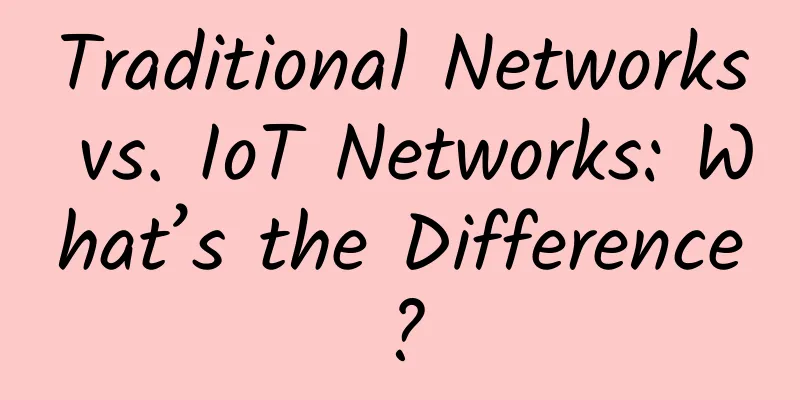Traditional Networks vs. IoT Networks: What’s the Difference?

|
IoT provides businesses with greater visibility, automation, and operational efficiency. Organizations that have begun to investigate the potential of deploying IoT must review the various IoT sensors and how these devices connect to and communicate with IoT server applications. Most people think of IoT networks as simply connecting to a traditional corporate LAN. While this is true in some cases, IoT network connectivity takes a broader approach to networking and expands connectivity options. What is a traditional network?Traditional enterprise networks usually consist of the following components:
LANs and WLANs are private wired and Wi-Fi networks that are typically deployed within corporate offices and branch offices. WANs are responsible for secure connections between LANs and branch offices. Finally, the Internet edge is the point or points where ingress and egress traffic can reach the Internet. What is the Internet of Things?The Internet of Things is a collection of autonomous devices connected to the internet that businesses can deploy to automate many business-related tasks. IoT devices use a variety of sensors, monitors, and other technologies to collect data. The data is then transmitted over the internet to a central repository management application for analysis. Depending on the role of the IoT system, it can use the analyzed data to initiate automated responses or make a variety of business-related decisions. IoT devices can use standard Ethernet, Wi-Fi, or many other wired or wireless connections and network protocols based on standards or proprietary. This diversity allows for greater deployment flexibility because IoT devices can often operate over low-bandwidth links. Traditional Networks vs. IoT: How Do They Compare?IoT systems are different from traditional networks, but they use network connections to operate. Devices in IoT systems rely on network connections to capture data that is transmitted to centralized servers for analysis. IoT devices can also react to various feedback based on processes driven by a centralized IoT management system. However, unlike traditional enterprise components, IoT architectures and devices can be distributed over a wide geographical range. Enterprises typically implement IoT sensors on traditional enterprise wired and Wi-Fi networks for communication access. However, organizations can also place IoT sensors on non-traditional networks, including public and private cellular, Bluetooth, Zigbee, and long-range WANs. Users can also place IoT devices in their home network as long as they can access IoT management services over the Internet. Because of this, IoT can be far beyond the coverage of traditional networks, making it a flexible choice for network deployment. |
<<: Does eSIM have a big impact on mobile network operators?
>>: Driving innovation and unleashing the unlimited potential of fiber optic LAN
Recommend
TNAHosting: $5/month-4 cores/12GB/500GB/15TB/Chicago data center
TNAHosting is a foreign hosting company founded i...
Huawei's Li Jie: Leading with innovation and continuously consolidating high-quality 5G networks
[Shanghai, China, June 5, 2023] At the 2nd Mobile...
Network security programming: C language reverse loop structure analysis
[[392807]] The loop structures of C language incl...
What do we need to do to make IPv6 a reality?
After the General Office of the CPC Central Commi...
Seven types of networks and their use cases
A computer network is a system of interconnected ...
Will 5G eliminate Wi-Fi/4G? No, multi-access network integration is the way to go!
The advent of 5G brings not only new technologies...
One person, one device, one password: Ruijie Flexible Office provides Lujia Paint with a "Wi-Fi Security Key"
Since the advent of Wi-Fi, users have had to face...
As VR enters its heyday, how will the three major operators plan their layout?
As we all know, VR is a very popular technology n...
Interview Question Series: 12 Deadly Questions on Network
1. What is your understanding of the TCP/IP four-...
KhanWebHost: $1/month KVM-2GB/10GB SSD/1TB/Dallas Data Center
Need to practice VPS hosting? You can take a look...
New infrastructure has boosted the multi-billion-dollar 5G optical module market, and the high-end sector urgently needs to increase the domestic production rate
2020 is a big year for 5G capital expenditure. Be...
Goodbye, endless pop-up ads
In recent years, with the rapid development of mo...
New infrastructure: Should we pursue this biggest “trend” in 2020?
If you want to find a keyword that can dominate t...
Huawei's new generation of 400GE data center switches enable new infrastructure and stimulate new momentum
[Shenzhen, China, July 24, 2020] At a press confe...
HTTPS 7-way handshake and 9 times delay
HTTP (Hypertext Transfer Protocol) has become the...








![[Black Friday] DediPath: 35% off VPS/Hybrid Servers starting at $1.2/month, 1Gbps unlimited traffic, multiple data centers in Los Angeles and other places](/upload/images/67cabff351bf1.webp)
